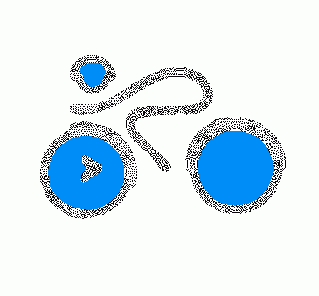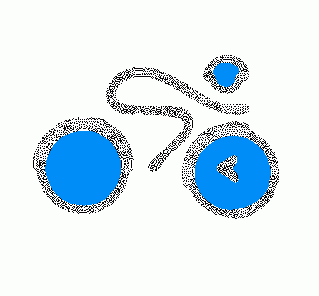| Newsletter - 2022 Archive |
 |
Cycling Club |
 |
| Newsletter - 2022 Archive |
 |
Cycling Club |
 |
Next--->
|
Ma Ma Ma My Stenosis* "Why are you SOO SLOW?" I think I had been in denial. For years I kept getting weaker and slower, but I thought that maybe it was just aging. Eventually I reached a level of decline where it no longer seemed like just aging. Other riders my age weren't losing much cycling power, while my strength was continuing to steadily decline. In the fall of 2016, I began to notice what felt like a pulled muscle in my right quadricep that wouldn't heal. Over the next few years, it became more painful, but was never bad enough that I had to stop cycling, so I kept not looking into it. Symptoms The pain in my right quad came with muscle weakness. I was beginning to feel pain in my right hip flexor too. It was worse when I was climbing, especially on steep grades, and my climbing speed had become painfully slow. As time went on my right leg started to buckle - not move through the peddle rotation smoothly - and it felt like I had only limited control of the leg. There was another curious symptom: my right ankle became weak, floppy. All these problems were only felt on the bike, and only when exerting past a certain level. There was no problem walking or cycling at a low exertion level. In the lead up to PBP 2019, I finally thought I needed to do something. I thought it was muscle tightness and that massage might help. I ask Cheryl Lynch if she could recommend a good massage therapist. Cheryl instead recommended a Physiotherapist - let's call her "Physiotherapist L". After describing my symptoms to Physio L, she started asking me about lower back pain. Talk of "L3, L4" (lumbars) was new to me. I was thinking that the problem was in my leg, so why is she talking about my back? Knowing that PBP was only a few weeks away, she suggested a session of IMS (intramuscular stimulation using needles) on my right quad and my lower back, and about 10 minutes with a massage machine strapped to my quad. PBP 2019 ...was a bit of a disaster. It was my 7th PBP and my finishing time was 14 hours slower than my next slowest time. There were a variety of problems, but right leg weakness, particularly while climbing through that beautiful rolling landscape, was a part of it. Diagnosis Following PBP I decided to take the matter more seriously and I booked an appointment with my GP ("Doctor G"). After my description of symptoms, he suspected scarring in the right quad, and ordered an MRI. He also thought that it would be a good idea to go back to Physio L for more treatment. The MRI was negative for scarring, so it was something else. Doctor G referred me to the Alan McGavin Sports Medicine Centre at UBC where I met with sports med doctor "Doctor N". Like Physiotherapist L, Doctor N started talking about my lower back. He ordered a CT scan. The CT scan was revealing. There was an irregularity in my spine. Doctor N searched for words as he pressed his knuckles together to illustrate the structural problem. There was a problem with the alignment of my vertebrates. "It's something that happened when your body was developing in adolescence... it's just now catching up to you." Doctor N prescribed physiotherapy. He recommended Treloar Physiotherapy, Cambie. Although when discussing it with me Doctor N seemed confident in his diagnosis, the note he wrote for the physiotherapist more guarded. "He may have some Stenosis." I soon learned that the full name of the condition is "Lumbar Spinal Stenosis". There were only a couple of the many physiotherapists at Treloar that mentioned cycling in their bios. One of them mentioned leading spinning classes and working with distance runners. Close enough. I arranged my first session with "Physio J" just a few days after Doctor N's diagnosis. That was in January 2021. Months of intensive physiotherapy followed. Treatment The intent of the physiotherapy was to strengthen and stabilize my lower back. The exercises were mainly lower body movements while activating (tensing) my transverse abdominal muscle, but not tensing the rest of my torso. Physio J suggested that I keep doing the quad and spinal stretches recommended by Physio L, and she introduced a few more. There were 12 sessions at Trelour with Physio J. My daily exercise routine at home built to about an hour a day, and there were refinements and gradual increases in difficult. In mid-May 2021 I graduated from Trelour, and continued the exercises at home. I was doing the full hour-long routine daily until September 2021 when I tapered to three days a week and an abbreviated 40-minute routine. In May 2021, following my sessions at Trelour, I checked in again with Physio L at Burrard Physio for a second opinion on Physio J's exercises. Physio L approved of the exercises. She suggested trying a little more IMS to see if that might help, and made some refinements to my spinal and upper leg stretches. Treatment Results Discouragingly I can't say that any of these treatments has improved my condition. I carry on with the exercises in the hope that the routine is at least slowing down the deterioration. I've also continued to see sports med Doctor N. We've talked about surgical options. He doesn't think I'm a candidate at the moment, because there is no problem with walking or any other leg activity. In other words I can do everything, except long distance cycling. He recommends continuing the physio exercises. In December 2021 Doctor N floated a new condition to consider: "iliac artery endofibrosis". He wondered if it might be occuring in conjunction with stenosis. It's a condition involving blood circulation which has been observed in male endurance cyclists younger than 40. That's me! ...except for the under 40 part. Again, the symptoms closely matched mine. I was off for another CT scan. This time it was an angiography - a contrast agent is inserted in the blood stream so the veins and arteries are visible during imaging. The result came back negative for iliac artery endofibrosis, but the report re-emphasized the misalignment in my spine. That's where we are as of Summer 2022. Riding I was able to do almost all of the pandemic brevets in 2020, 2021, and have pressed on with the 2022 brevets, but I think my ability to keep ahead of the time limits may be slipping away. There are already routes that I'm not starting, because I know I won't be able to keep ahead of the limit. The deterioration has been very very slow. It's been clearly noticeable for about 12 years, but on reflection has been affecting me for longer. Other riders have noticed. Years ago, they started saying things like "What are you doing way back here with us", "Hey, thanks for riding with us," "Are you feeling ok?" Because the decline is so gradual, I may still have some years of randonneur cycling. Maybe the condition will plateau - not get any worse. PBP 2023 and Beyond I plan to be at the start line of PBP 2023. We'll see how that goes. Winding down in my early-mid sixties was not the plan. I was planning to continue doing lots of randonneur cycling through my sixties, and finishing 3 more PBPs, totalling 10, which would happen when I am 72. By a happy coincidence this would be on the centenary PBP Randonneur in 2031. It felt fated. From there on I would ride 200s for as long as it wasn't too uncomfortable. This plan now seems unlikely, but I'm still hoping. * Why the "Ma Ma Ma" in the title above? When the word stenosis was newly in my brain, I began to hear it musically. Specifically, I started to hear it as "My Sharona" the infectious 1979 hit by the Knack. Now I can't get it out of my head. After a while I realized that there is another hit song that has the "Ma Ma Ma" phrasing: "My Poker Face" by Lady Gaga, and that too is in my brain when I sing the word stenosis, though it doesn't flow, like my Sharona.
Go to: - August 10, 2022 |